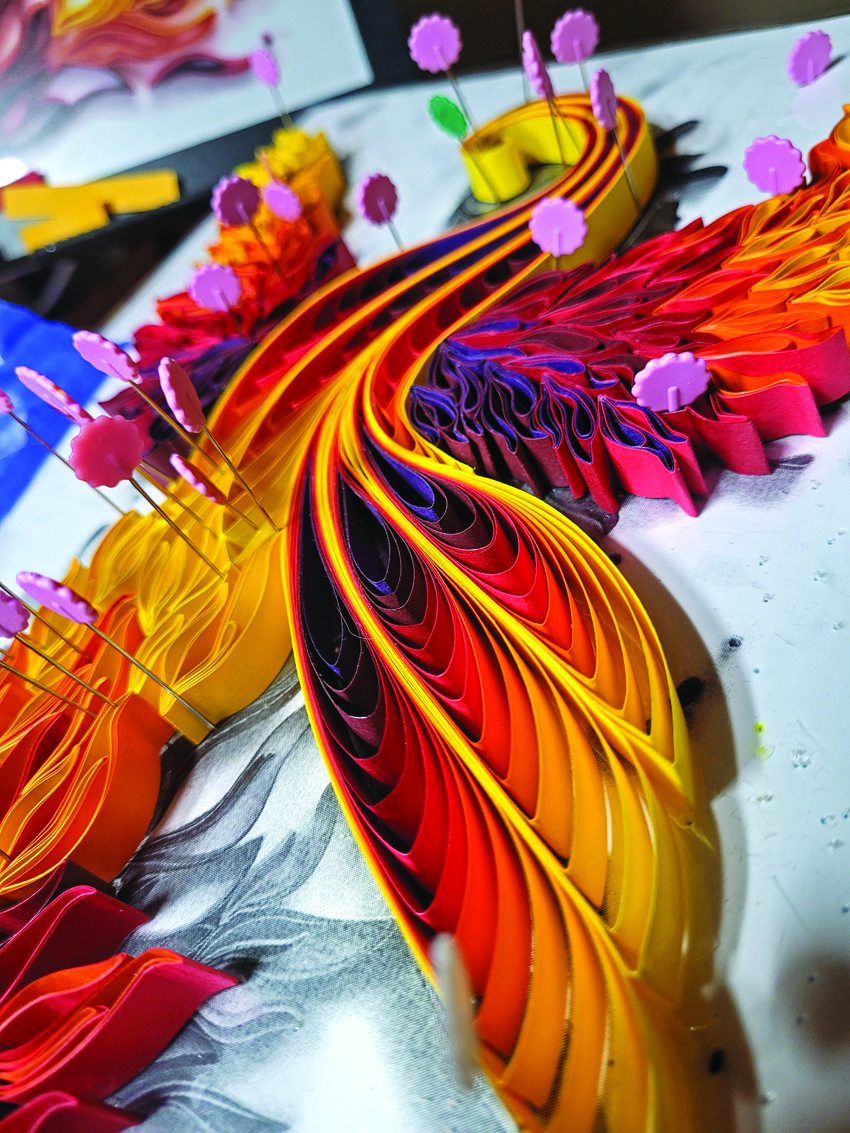
A quilled betta fish, one of Stacy Bettencourt’s tutorial designs. While how-to materials for quilling are in high demand, she said, her process is intuitive and time-consuming, taking up to 60 hours per piece. (Photo courtesy Stacy Bettencourt)
Stacy Bettencourt began as an artist by drawing what she saw around her childhood home in Jefferson. These days, her specialty in paper quilling carries her work across the world.
The Jefferson native is most well known for this work, an art form of curling thin strips of paper into small shapes that make up a larger image. She is also a photographer with a specialty in dog portraits, a painter, and a charcoal artist.
“There’s a million and one painters … but you don’t see people trying to paint with paper,” she said of her success in the form.
Her first memory of artwork was a mural of pansy flowers in oil pastel on the walls of the closet in her childhood bedroom. She grew up drawing what she knew, she said — photos of ducks and other wildlife from sportsmen’s magazines around her house as well as the children of friends and neighbors.
Throughout her life, Bettencourt has always made art in different forms, and she said she could never go without it. She holds degrees in English and technical writing and works part time to enjoy more freedom in her artistic practice.

Stacy Bettencourt works on a quilled daisy. She said inspiration strikes suddenly, and once an image comes to mind she can see final project in paper. (Photo courtesy Stacy Bettencourt)
Bettencourt began quilling in 2014 at the introduction of a cousin. She thought it would involve flattened porcupine quills, but took to the surprise of paper quickly.
She is still at work on hand-rolled teardrops, loops, coils, and other shapes glued in place to create portraits, animals, buildings, and flowers that often take up to 60 hours to complete.
Bettencourt said she enjoys the challenge and the perfection required to put together a quilled image.
She likens the work to “finger gymnastics,” rolling and shaping each small piece of paper. Some of her more elaborate works even have scaffolding to balance the three-dimensional elements.
Quilling was popular in the 1970s for cute, decorative motifs, Bettencourt said, and ready for her to take it in new directions.
Her quilling work has since branched out into other paper art, like stacked three-dimensional construction and abstract collages in hand-painted paper.
Her projects are now in national ad campaigns and homes and offices worldwide, as far away as Guam and Portugal.
“I’m always looking for something different, like a new art form,” Bettencourt said. “There’s a lot of pioneering that goes on,” in her own work and in the online quilling community she is part of.
Online paper groups on Facebook and Instagram have connected her to artists in India and the United Kingdom, where the form is popular, and she has watched artists she mentored grow in their skills over the years.
Those platforms have become central to Bettencourt’s own success. Two portraits in particular, one of a phoenix and the other a face of a lion, took off in popularity when posted online.
“I have people messaging me constantly asking me to look at their stuff or telling me that I was their inspiration or I was the reason why they had gotten into quilling, because they saw my phoenix or lion,” she said.
Bettencourt said opportunities seem to find her since, from two television show offers to several national ad campaigns to the book she wrote in 2019.
“Paper Monograms: Create Beautiful Quilled Letters,” published by Becker & Meyer, outlines basic techniques for quilling decorative letters.

A quilled paper pet portrait by Stacy Bettencourt, one of her popular offerings. Bettencourt also offers dog photography in the Jefferson home studio where she makes paper art, paints, and draws. (Photo courtesy Stacy Bettencourt)
Last summer, she was also featured in Downeast Magazine, an article that brought in pet portrait commissions from the across the country that she is still working through.
Outside of commissions, Bettencourt said ideas for her artwork manifest suddenly, and she needs to make them real once they appear.
Some of her favorite subjects are animals, but she also uses her paper art to pay tribute to things important to her.
“I think it’s a way of experiencing it internally … when you’re understanding that or coping with it by turning it into art,” she said.
She keeps a folder of over 3,000 project ideas, but often sees things in real life that turn into art, too — her phoenix piece, for example, was inspired by a tattoo.
Bettencourt has also made video tutorials in the past for more basic designs, and intends to again when her commission backlog slows, but said paper work is for the patient.
“It’s like watching cold molasses run uphill,” she said. “It’s the slowest art form you could possibly choose to do.”
Teaching can also be a challenge simply because Bettencourt’s process is so intuitive.
“It’s … a matter of seeing something and then it just pops into my head, the finished product,” she said. “Every time I see something that inspires me, I envision it in the format of paper art.”
Bettencourt is still active in painting, photography, and charcoal drawing, with plans to expand her pet portrait business, but “always comes back to paper.”
“Maybe I do subconsciously recognize the unique nature of the art form,” she said.
To see more of Bettencourt’s art and find links to her projects, go to quantumartistic.com.

A quilled phoenix in process at Stacy Bettencourt’s Jefferson studio. Bettencourt said the work of quilling is “finger gymnastics,” rolling and shaping many small coils of paper to make a complete image. (Photo courtesy Stacy Bettencourt)



